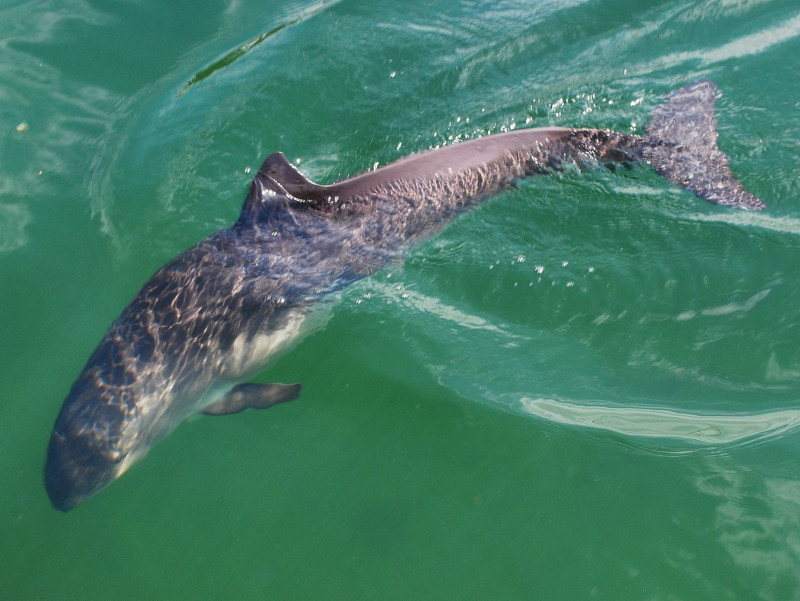
Harbor Porpoise Facts
- Perhaps most notably, the term of Harbor Porpoise serves as the most frequently used of the common names for a stunning marine mammal. Like many species, though, the stunning creature also goes by other names, in various portions of its native range.
- These terms include such diverse names as the nise, and, for unknown reasons, the somewhat humorous name of the puffing pig. Its official, scientific name, however remains that of the unique, and hard to pronounce, term of Phocoena phocoena.
- Regardless of which name one uses to refer to it, though, this magnificent creature represents one of only six or seven known surviving species of porpoise. The current discrepancy occurs due to ongoing debates over whether or not one is a subspecies.
- The first known scientific description of this marvelous cetacean occurred in 1758. This comparatively important footnote in scientific history also holds another distinction. That’s because it occurred at the hands of the Swedish zoologist, Carl Linnaeus.
- However, the animal itself had long been known to portions of mankind. That awareness, in fact, dates back to ancient times. In modern times, though, for the moment, the Harbor Porpoise appears to be maintaining a fairly sizable population.
- The IUCN nonetheless currently lists the mammal as Vulnerable. This status appears on its Red List of Threatened Species. Furthermore, this occurs due to concerns over the extreme vulnerability of the species to potential habitat loss and climate change.
Related Articles
Vaquita
Harbor Porpoise Physical Description
Although the Harbor Porpoise remains an impressive specimen of a marine cetacean, it does not earn that status due to size. Even among other porpoises, it’s smaller than average. Yet, it’s not the smallest of the porpoises. That distinction currently belongs to the Vaquita.
This fascinating mammal additionally displays a very slight degree of the physiological characteristic of sexual dimorphism. That remains a characteristic it shares with most of its relatives. In its case, though, that characteristic manifests itself in terms of mass.
That holds true since the females of this particular species have an average body weight equaling 25 – 30 percent more than the males. However, both genders attain roughly the same body length. The females, therefore, have a much thicker-bodied appearance.
In fact, each of the sexes typically reaches an average length that measures between 4.6 – 6.2 ft (1.4 – 1.9 m). In terms of weight, though, males reach an average weight of approximately, 134 lb (61 kg). Meanwhile, though, the bulkier females average a weight of 168 lb (76 kg).
The genders appear similar otherwise. The body of the animal develops as robust, being widest near the dorsal fin. The sides display a light gray, with speckling. The tail fin, back, flippers, and dorsal fin show a dark gray. The underside, though, displays a white in color.
- Kingdom: Animalia
- Phylum: Chordata
- Class: Mammalia
- Order: Artiodactyla
- Family: Phocoenidae
- Genus: Phocoena
- Species: P. phocoena
Harbor Porpoise Distribution, Habitat, and Ecology
Quite amazingly, the beautiful Harbor Porpoise has a uniquely broad range of natural habitation. It’s also simultaneously highly restricted in some ways, though. That somewhat confusing state of affairs occurs because of a combination of factors, however.
Firstly, the beautiful marine animal appears in parts of the Black Sea, the North Pacific, and the North Atlantic. Secondly, however, the animal further only appears in narrow bands. These, as it happens, most often extend along the coastal regions of the continents.
The greatest concentration appears along the coasts of northwest Europe. Its very name provides an indication of its habitat. That’s due to the fact that the cetacean only appears in shallow waters, often near, or even in, various harbors and bays in its region of habitation.
In point of fact, this stunning creature rarely dwells in waters possessing a depth of greater than 500 ft (152 m). The magnificent Harbor Porpoise also frequently travels inland waters. This extension of its range typically includes estuaries, and even far up rivers.
Throughout the entirety of its range, it feeds on a variety of prey. These mainly consist of small fish travelling in schools. But, it also consumes smaller squids and crustaceans on occasion. Understandably, though, its exact prey varies depending on individual location.
Quite sadly, reliable data about much of the life cycle of this fabulous creature presently remains in short supply. Yet, some evidence indicates that this animal prefers to stay within a limited area. This has the regrettable effect of leaving the marvel quite vulnerable.
The creature also appears that the impressive species lives a primarily solitary life. Most often, observed specimens appeared either alone, or in small groups of no more than 5 individuals. It also seems to possess a relatively short lifespan, measuring only 8 – 13 years.
Species Sharing Its Range
Check out our other articles on 4 Stupendous Stick Insects, Guinan cock-of-the-rock, Milford Sound, Chickasaw Plum, Cairn’s Birdwing, Snow Leopard, Indian Bullfrog, Mexican Mole Lizard
